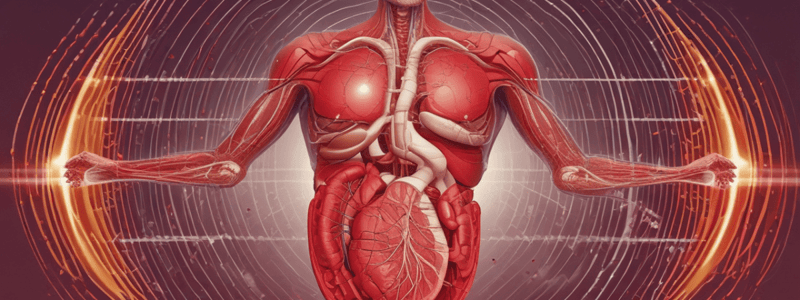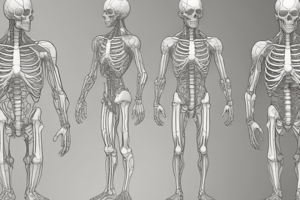Podcast
Questions and Answers
What is the primary goal of on-scene management of bleeding patients?
What is the primary goal of on-scene management of bleeding patients?
Which of the following patients requires immediate transportation to the hospital?
Which of the following patients requires immediate transportation to the hospital?
What is the trauma triad of death?
What is the trauma triad of death?
What is the first step in patient assessment?
What is the first step in patient assessment?
What is the purpose of the primary survey?
What is the purpose of the primary survey?
How often should vital signs be recorded during patient assessment?
How often should vital signs be recorded during patient assessment?
What is the primary purpose of perfusion in the body?
What is the primary purpose of perfusion in the body?
What is the most common method of controlling external bleeding?
What is the most common method of controlling external bleeding?
What is a common sign of internal bleeding?
What is a common sign of internal bleeding?
What is the primary cause of hemorrhagic shock?
What is the primary cause of hemorrhagic shock?
What type of injury is most likely to cause internal bleeding?
What type of injury is most likely to cause internal bleeding?
What is the term for the discharge of blood from blood vessels?
What is the term for the discharge of blood from blood vessels?
What is a sign of hypoperfusion?
What is a sign of hypoperfusion?
What is the connection between the cardiac cycle and bleeding?
What is the connection between the cardiac cycle and bleeding?
Flashcards are hidden until you start studying
Study Notes
Bleeding and Shock
- Bleeding can be external and obvious or internal and hidden, leading to conditions such as weakness, shock, and death.
- Perfusion is the circulation of blood within an organ or tissue in adequate amounts to meet the cell's current needs for oxygen, nutrients, and waste removal.
Cardiac Cycle
- The cardiac cycle is a repetitive pumping process that begins with the onset of cardiac muscle contraction and ends with the beginning of the next contraction.
- The cardiac cycle is connected to bleeding and shock through its relationship to blood pressure.
- Delivery of oxygen to the tissues is dependent on an adequate heart rate, stroke volume, hemoglobin levels, and arterial oxygen saturation.
Bleeding
- Hemorrhage is the discharge of blood from blood vessels, ranging from minor capillary bleeding to severely spurting arteries.
- External bleeding is often controlled by using direct pressure, pressure dressings, splints, hemostatic dressings, tourniquets, and pressure bandages.
- Internal hemorrhage may appear in any portion of the body, occurring with non-traumatic internal hemorrhage such as GI bleeding, ruptured ectopic pregnancies, and ruptured aneurysms.
Mechanisms of Injury
- High-energy mechanisms of injury, such as falls, blast injuries, and MVCs, increase the index of suspicion for serious unseen injuries.
- Penetrating injuries or significant blunt trauma can cause internal bleeding.
Signs and Symptoms of Bleeding
- Signs of internal bleeding include dizziness, faintness, weakness, pain, swelling, bruising, distension, hematoma, and vomiting blood.
- Altered level of consciousness, tachycardia, weakness, fainting, dizziness, and thirst are signs of hypoperfusion.
Hemorrhagic Shock
- Hemorrhagic shock is the condition in which blood flow volume results in inadequate perfusion and even death.
- Uncontrolled bleeding, whether internal or external, can eventually lead to hemorrhagic shock if not corrected.
Management of Bleeding and Shock
- Patients with significant bleeding or suspected internal bleeding should be transported to the hospital immediately.
- On-scene management includes controlling external bleeding, providing oxygen, and covering the patient to prevent heat loss.
- Patients with bleeding disorders or taking medications that interfere with clotting mechanisms require immediate transportation.
- The trauma triad of death includes hypothermia, coagulopathy, and acidosis, which increase mortality in trauma patients.
Patient Assessment
- Patient assessment should begin with scene size-up, ensuring the scene is safe and taking appropriate standard precautions.
- The primary survey should be used to search for life-threatening bleeding, control it, and assess the patient's level of consciousness, airway, breathing, and circulation.
- Secondary assessment should uncover any injuries or illnesses missed during the primary survey and gather information about the patient's chief complaint and MOI.
- Vital signs should be recorded every 5 minutes, and the patient's respiratory, cardiovascular, neurologic, and musculoskeletal systems should be assessed.
Bleeding and Shock
- Bleeding can be internal and hidden, leading to weakness, shock, and death
- Internal bleeding can be caused by non-traumatic internal hemorrhage, such as GI bleeding, ruptured ectopic pregnancies, and ruptured aneurysms
Cardiac Cycle
- The cardiac cycle is connected to bleeding and shock through its relationship to blood pressure
- Delivery of oxygen to tissues is dependent on adequate heart rate, stroke volume, hemoglobin levels, and arterial oxygen saturation
Bleeding
- Hemorrhage is the discharge of blood from blood vessels, ranging from minor capillary bleeding to severely spurting arteries
- External bleeding can be controlled using direct pressure, pressure dressings, splints, hemostatic dressings, tourniquets, and pressure bandages
Mechanisms of Injury
- High-energy mechanisms of injury, such as falls, blast injuries, and MVCs, increase the suspicion for serious unseen injuries
- Penetrating injuries or significant blunt trauma can cause internal bleeding
Signs and Symptoms of Bleeding
- Signs of internal bleeding include dizziness, faintness, weakness, pain, swelling, bruising, distension, hematoma, and vomiting blood
- Altered level of consciousness, tachycardia, weakness, fainting, dizziness, and thirst are signs of hypoperfusion
Hemorrhagic Shock
- Hemorrhagic shock is a condition in which blood flow volume results in inadequate perfusion and even death
- Uncontrolled bleeding, whether internal or external, can eventually lead to hemorrhagic shock if not corrected
Management of Bleeding and Shock
- Patients with significant bleeding or suspected internal bleeding should be transported to the hospital immediately
- On-scene management includes controlling external bleeding, providing oxygen, and covering the patient to prevent heat loss
- Patients with bleeding disorders or taking medications that interfere with clotting mechanisms require immediate transportation
- The trauma triad of death includes hypothermia, coagulopathy, and acidosis, which increase mortality in trauma patients
Patient Assessment
- Patient assessment should begin with scene size-up, ensuring the scene is safe and taking appropriate standard precautions
- The primary survey should be used to search for life-threatening bleeding, control it, and assess the patient's level of consciousness, airway, breathing, and circulation
- Secondary assessment should uncover any injuries or illnesses missed during the primary survey and gather information about the patient's chief complaint and MOI
- Vital signs should be recorded every 5 minutes, and the patient's respiratory, cardiovascular, neurologic, and musculoskeletal systems should be assessed
Studying That Suits You
Use AI to generate personalized quizzes and flashcards to suit your learning preferences.




